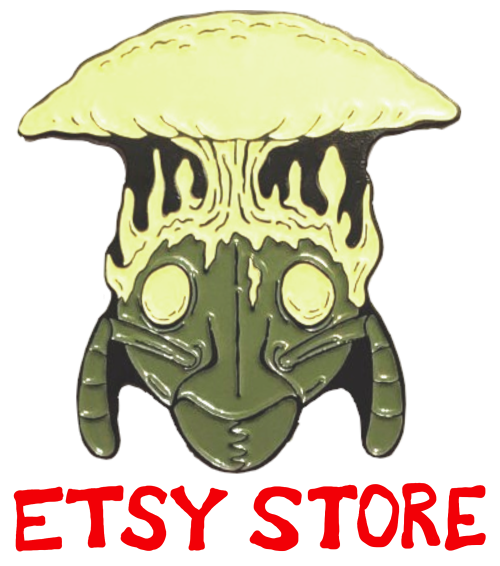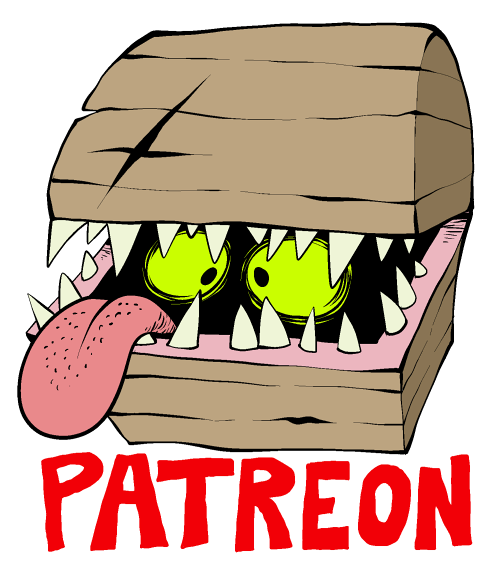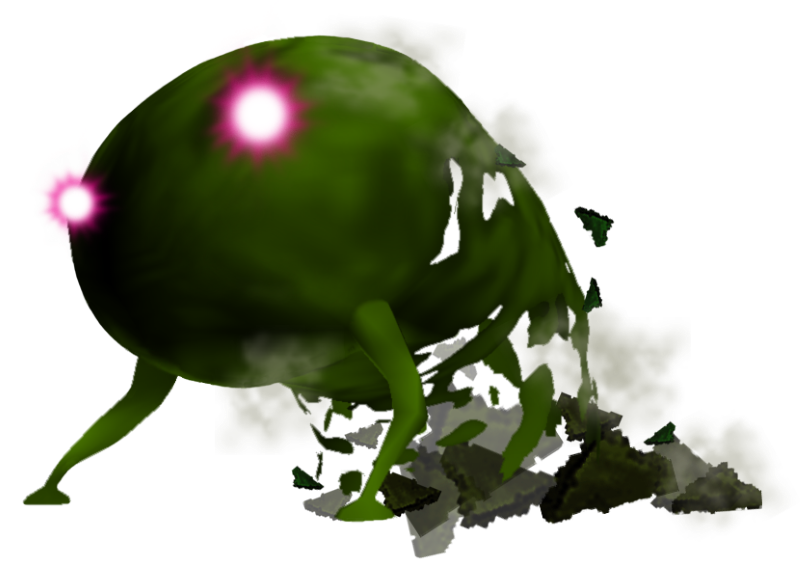
The Rock Pikmin
(Pikminidae habisaxum)
It's Pikmin 3 time! Yay! Hooray! Pikmin the third!!! That means the next time I review Pikmin stuff, it will be for the Game #4 everyone is so excited about!Pikmin 3 added these ultra-heavy, ultra-tough but very slow Pikmin, like an even more extreme take on the purples. Their body is a pleasantly chunky, angular, shiny silvery looking stone with goofy Pikmin eyes, while the head stalk and the limbs are pale white and more organic. The design and the scientific name both imply that the Pikmin actually grows inside of a stone, rather than genuinely being "made" of stone. I'm not as big a fan of "elemental" Pikmin, but the rock ones are nicely designed and not unbelievable!
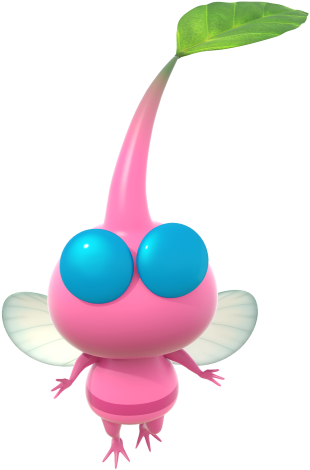
The Winged Pikmin
(Pikminidae volarosa)
*Aesthetically* my favorite Pikmin, because they may not be parasitic or poisonous, but they do have both the wings and eyes of a fly! They even have much larger heads, proportionately, and little rounded bodies with a single stripe around their midsection, to look even more like a segmented insect abdomen! All Pikmin are cute, but these are by far the cutest.

The Whiptongue Bulborb
(Oculus longolingua)
A pretty logical adaptation for a grub-dog! It can be assumed most Bulborbs eat all manner of prey, but the Whiptongue is specialized for consuming tinier things in large numbers. Just like an anteater, aardvark, aardwolf, echidna, ant bear, a number of oddball birds and various other ant or termite-eating vertebrates in our own world, it feeds with an extremely long and extremely sticky tongue. It even has a tapering little snout, with a tiny mouth and no teeth.
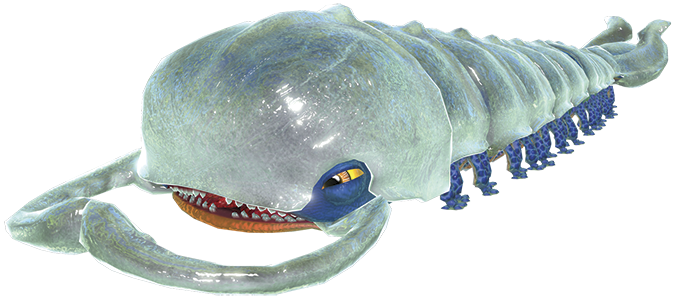
The Armored Mawdad
(Tuberclipeum rex)
Like the Mawdad of Pikmin 2, this animal has a segmented, tapering body with a rounded front, kind of like one big lobster tail, though its face reminds me more of a cartoon whale, like Disney's Monstro, with a wide mouth full of blunt teeth and sinister little eyes. It also has rows of tiny, sucker-toed reptilian feet, a pair of large crescent mandibles that end in blunt, crushing knobs, and its exoskeleton has a translucent blue-tinged pearl sort of sheen. It's a "crystalline" armor that can only be cracked by the Rock Pikmin.Despite its crustacean-like appearance and English name, Mawdads are apparently "Myriapods," like millipedes and centipedes!
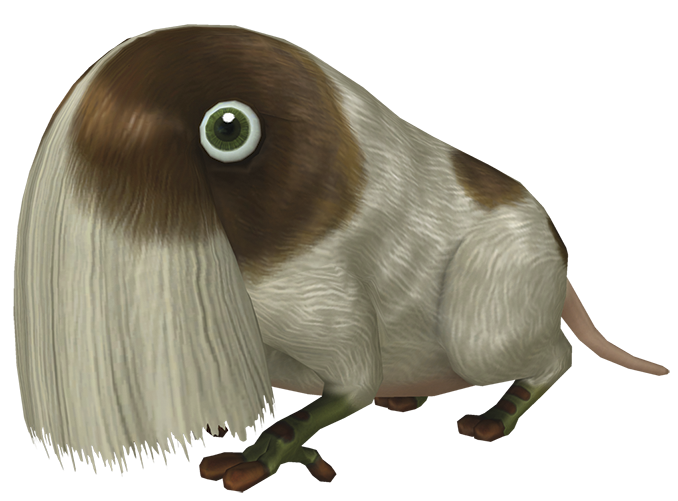
The Bearded Amprat
(Porcellus barbavolta)
A four limbed mammal is such a rarity in this setting, it feels jarringly out of place. I wouldn't have thought any existed on Pikmin Planet! It's still a creatively odd animal, though; kind of like a guinea pig with big staring eyes and no ears, but it also has long hair that droops down over its face, covering its nose and mouth. It attacks by rapidly rubbing this "beard" to build up static, then releases an electric shock, during which it exposes its gnashing rodent teeth and eats as many paralyzed Pikmin as it can.
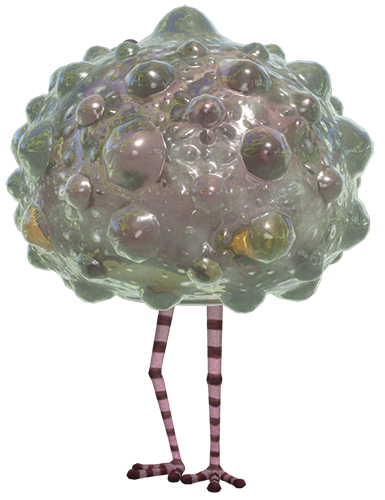

The Calcified Crushblat
(Durotesta longuscrus)
TOO CUTE. The Crushblat is nothing but a big, fat, mottled brown head, slightly squashed, with bulging yellow eyeballs set low and far apart, each eye surrounded in long whiskerlike lashes. It doesn't have a mouth, but its yellow underbelly swoops up a little between the eyes and ends up really looking like a mouth area. It just has SUCH an innocent, sweet expression. It only has one pair of appendages, very thin, almost birdlike pink-striped legs, and these can rapidly extend or almost completely retract. The entire head is also usually encased in a clear, lumpy layer of silica, and it attacks by slamming down from above, kind of like the setting's frog creatures. Olimar says it evolved from a mollusk that feeds by slowly absorbing nutrients thrugh its skin, which is notably not very efficient, but that's why it spends most of its time sleeping!
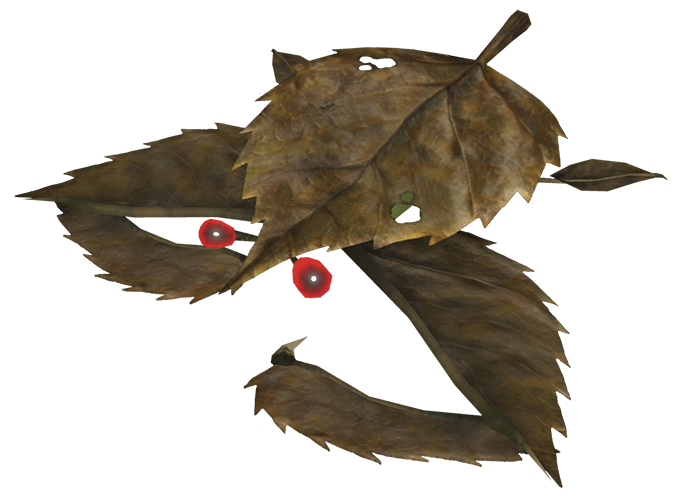
The Desiccated Skitterleaf
(Rus mortifeuillea)
R. mortifeuillea is like the Skitterleaf introduced in Pikmin 2, but it imitates dead, brown, rotten leaves complete with a few strategically placed holes. The false leaf body is also turned around, so the leaf's stem is the "tail" and the leaf's pointed tip is the animal's proboscis. Its berry-like eyes are also a little more elongated and crablike, and its forelimbs are much, much larger. Whereas the regular Skitterleaf had thin, stalklike upper limbs ending in leaf-shaped forelimbs, this one's upper limbs are big, serrated half-leaves, and its spiny, swooping forelimbs curl inward with a hooklike claw. They're more crab-like or mantis-like, a little of both, and they look a lot more dangerous because this is a fully predatory Skitterleaf!Olimar also explains that the Skitterleaf's camouflage allows its eggs to be spread around by scavengers, but he doesn't explain whether this means the eggs stick to unwitting detritivores or they actually eat the Skitterleaf, passing eggs through their digestive tract.
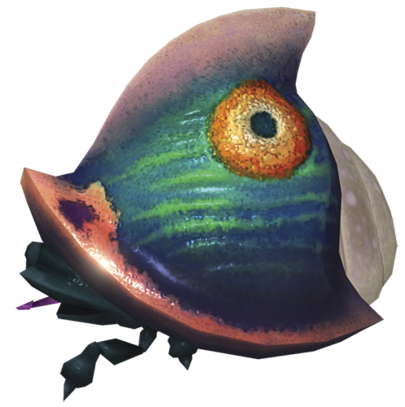

The Joustmites
(Trilobitins reversa)
These are related to the Cloaking Burrow-Nit from the last game, but their shields, with similar "false eyes," are actually on the head end of their bodies, and their real heads are dark, almost toadlike faces with the "proboscis" as a tongue. I don't find them quite as endearing as the burrow-nit, but the differences in physiology are interesting. The helmets are actually easily detachable, so do they even grow their own, or steal them from another species? They also come in a flying variety, Trilobitins reversa volanti, having a single pair of insect wings.
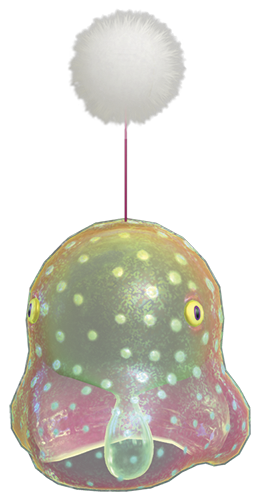
The Medusal Slurker
(Stauromedusae manifoldii)
Another personal favorite! Why wouldn't it be?! It's a beautiful, transparent bell of jelly, a bit more like a flapjack octopus in shape than any jellyfish, with a dandelion poof on top of its head and little yellow eyes with black, reptilian pupils. Its exterior is tinted pinkish orange but almost crystal clear, except for its polka dots, while its interior has a lime green jelly layer tapering into a teardrop-shaped organ, which it extends to grab and swallow things! "Medusal Slurker" is also just a fantastic name all around, its family (despite being the only known species) is given as "Umbloda," which also has a lovely ring to it, and its latin name interestingly comes from the real world "stalked" jellyfish, the stauromeduae.As alarming as its behavior is, however, it doesn't actually eat what it collects, merely holding Pikmin prisoner until they're rescued. They're permanently lost if the day ends, but Olimar still notes that he can find no traces of digestive enzymes in the Slurker.

The Nectarous Dandelfly
(Anisopterid ambrosius)
Pikmin 3 actually does away with the poor Honeywisp, but the Dandelfly is lovable too; its body is a fuzzy white sphere, its head is like that of a butterfly with an upturned, spiraling proboscis, it has eight membranous wings - four longer ones, four stubby little ones - and trails five shiny, golden segments resembling the swollen abdomens of honeypot ants! It's completely nonviolent, like the wisp, and just another source of nectar if you're vicious and sadistic enough, though you still wouldn't be as brutal as Louie, whose log entry says to just tear its meat from its belly and eat it in raw chunks.
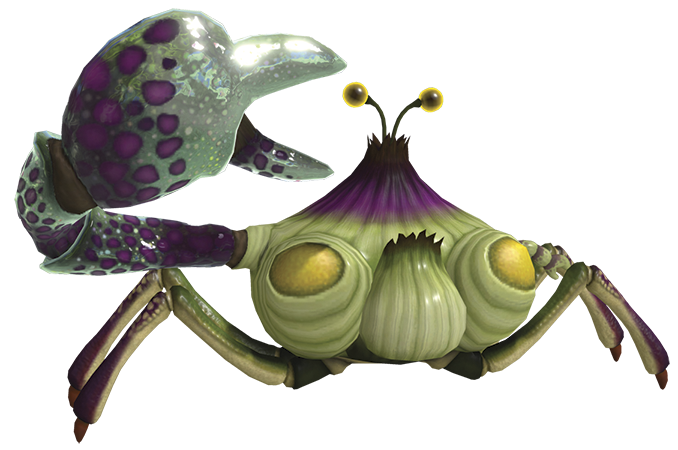
The Peckish Aristocrab
(Brachyurices esurio)
An amphibious enemy, the aristocrab attacks with its right right claw or by blowing bubbles, which can trap individual Pikmin. A straightforward crablike nemesis, but it has a fun design; the body is just a big clove of garlic, for whatever reason, with a funny garlic clove underbite between two large, yellow eye-like nodules, giving it a pug-like face. Those "eyes" actually appear to just be cheeks, though, the actual eyes probably those little, translucent balls on its two antennae.
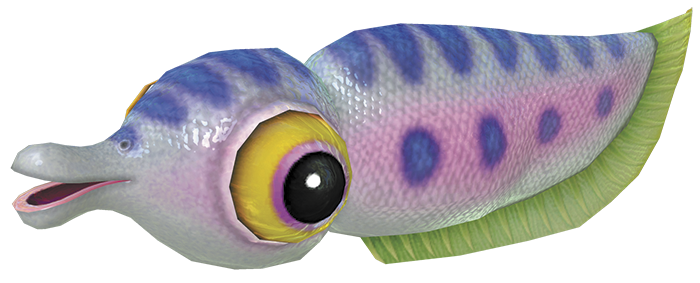
The Puckering Blinnow
(Narrolingus piscatum)
A delightfully odd fish that feels straight from our own prehistoric seas, the blinnow has a simple, pointed tadpole-like body with a single green fin running along its underside, a round head tapering into a small, pointed bill and extra massive, bright yellow eyeballs. As goofy as it is, though, it's pretty fearsome! It'll try to grab any Pikmin it can, swim away with it and eat it, even leaping out of the water to catch your poor flying Pikmin!
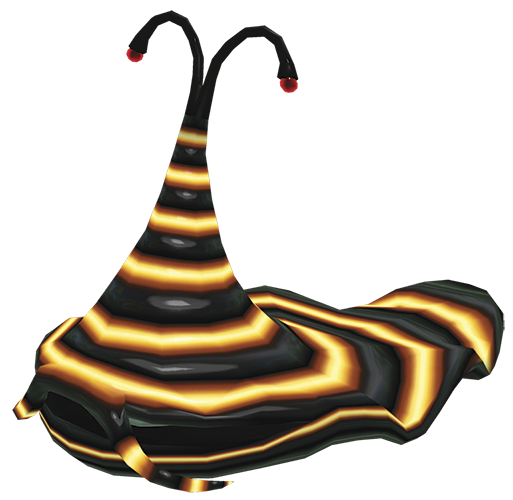
The Pyroclasmic Slooch
(Sulucina vulcanis)
Another with a really fun name, even if "Slooch" also sounds like it should be some kind of vulgar insult. It's a flat, rippling slug with a little mouth in front, flanked by a couple of whisker-like tentacles, and a head that tapers up into a tall, wobbly cone before it splits into dangling eyestalks. It's entirely black with intense striped of glowing orange-yellow, like a flowing pool of lava, and produces a flammable mucus that leaves a trail of fire wherever it goes. This is its defensive adaptation, but not its means of attack; it just slurps up what's in front of it with a big sticky tongue.
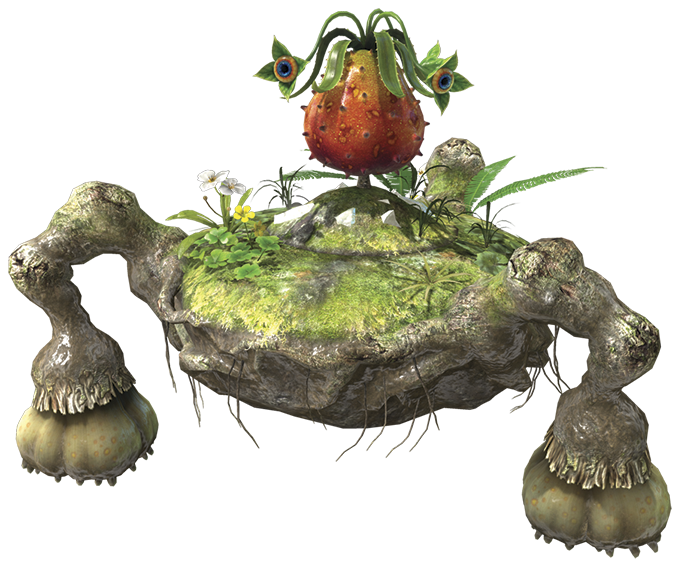
The Quaggled Mireclops
(Trestripods gigahenum)
The largest boss in the series up to this point is also a really inventive and cool idea for a plant creature! Its "head" or maybe its "main body" is a spiny, strawberry-shaped red fruit with serrated green leaves and two leavy green, flowerlike eye-stalks, but this grows from a patch of grass and flowers atop a large, circular chunk of earth held together by tangled roots, which walks around on three knobby legs ending in "feet" resembling yellow plant bulbs. So, I guess most of the Mireclops is entirely the massive, ambulatory root system of that cute little plant! Fun!
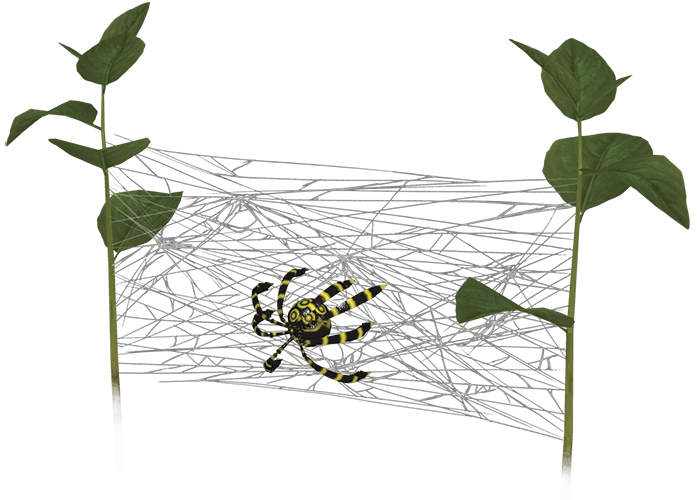
The Arachnode
This web-building "spider"-like enemy exists mostly to provide a unique hazard to your flying Pikmin, but it has pretty interesting physiology, too; it can curl up into a shape resembling nothing but a striped bulb, like a bee abdomen, but can unfold to reveal that its body is a perfect sphere, black with yellow spots, and it has eight flat, flexible, strap-like black and yellow legs with a texture more like snake's skin.
That's weird! I don't think it's possible to even get a glimpse of any mouth on it, even though it eats trapped prey through the underside of its sphere. It doesn't come across as any sort of Arthropod at all, physically, even less so than the long-legs or "arachnodes."
It's also said by Olimar to exhibit gynandry. This means its body is split evenly between a male half and female half, and he speculates that it may have two separate sexes that actually fuse together!
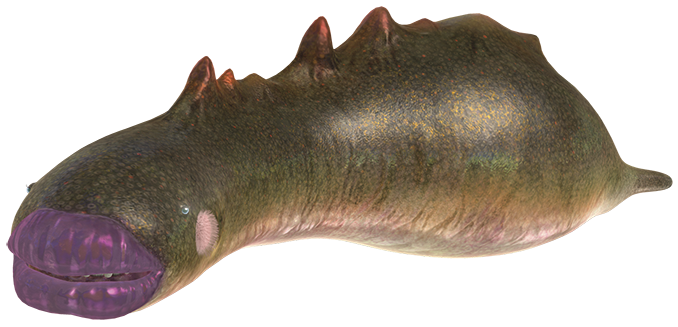
The Sandbelching Meerslug
(Gastropoidae anguilii)
Another favorite! This "slug" is more like a short, fat lamprey with a row of blunt, craggy spikes down its back, teeny tiny little eyes, a pair of strange fuzzy pink cheek spots and a set of big, purple human-like lips that conceal many sharp teeth. Besides its entertaining design, it lives exactly like a larval antlion at the bottom of a sand pit!
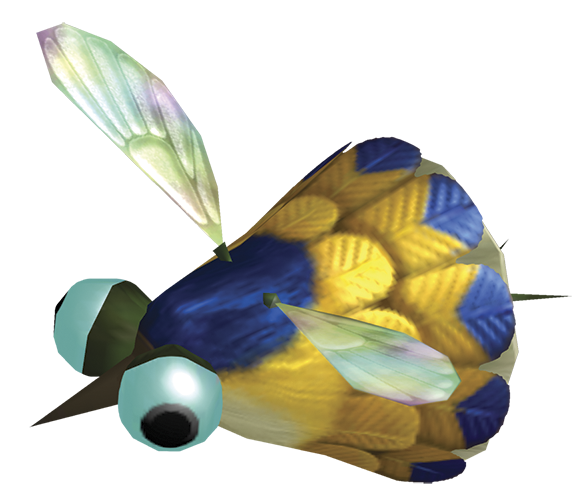
The Scornet
(Spourgitis advenus)
Scornets are funny little bird-bee chimeras, each resembling a cone of yellow and blue feathers with a tiny, dark beak between two oversized eyeballs, and a single pair of insect wings. Cute, though these are just the little workers of the swarm!
The lead Scornet is referred to as the "maestro," actually a huge female, this Boschian goofball controls the swarm with both pheromones and the harp-like strings stretched between the halves of her long, long beak. There's an insane quality to the small eyeballs at the base of that beak, staring in opposite directions with blood red irises. The rest of her is like a giant sized, four-winged Scornet with a cockatoo-like head crest and a pair of fuzzy arms to play her harp with. While not seen, a journal entry describes the male of the species as a smaller, flightless version of the maestro, with white body feathers and blue feet it runs around on.

The Bug Eyed Crawmad
(Camabarus subterranid)
This miniboss is mostly just a bigger, spikier Crawmad, modified from the design of Pikmin 3's regular Crawmad, which we talked about in the Pikmin 2 review, except "subterranid" also has much sillier, more cartoonish eyes on the ends of much longer, bobbing stalks. Olimar's description is especially scientific: "It has abnormally overdeveloped eyes with which to detect prey in
cloudy water or low-visibility mud. These enormous eyes can perceive
circular polarised light, as well as the ultraviolet and infrared ends
of the spectrum. It's well protected from predators, allowing it to live
for upwards of 50 years and grow to immense size by repeated ecdysis"How does he now it lives for 50 years, though?! Maybe the ship can just analyze that? I was pretty sure the entirety of Pikmin takes place in the span of just a few short years following the planet's "discovery."

The Iridescent Flint Beetle
(Pilli envelopens striaticus)
Pikmin 3 introduces a "subspecies" of P. envelopens, but this "subspecies" has an entirely different design. Whereas the common iridescent flint beetles of the previous games were simple, oval beetles with two short little eye stalks sticking out of the front, "striaticus" has a wide crab-like body, with two longer and more lifelike stalk eyes growing from the upper surface as well as a pair of long, thin antennae. It's a more elaborate and distinct looking creature with a goofy personality all its own, though it otherwise behaves the same.
The Waddlepus
(Opisteuthidae iaciobulla)
It's so hard not to just talk about the cuteness of every single thing in these games, but there are only so many words in the English language for that. I guess it just doesn't need to be said here, you knew it was cute as soon as you heard the name "Waddlepus." More like some sort of nubby starfish than a Cephalopod, it's a dome shaped creature with pebbly purple skin, the dome just "pleated" a little into five lobes, rather than more distinct tentacles. It has two very big octopus-like eyes and an even bigger, circular sucker-like mouth. Its top surface is also covered in smaller, yellow suckers, and these blow bubbles as its sole defensive strategy. It's not carnivoros or aggressive and only wants to be left in peace, but the bubbles will trap you and your Pikmin, floating you around, potentially exposing you to other dangers! Still no excuse to bully something called a WADDLEPUS. How could you. 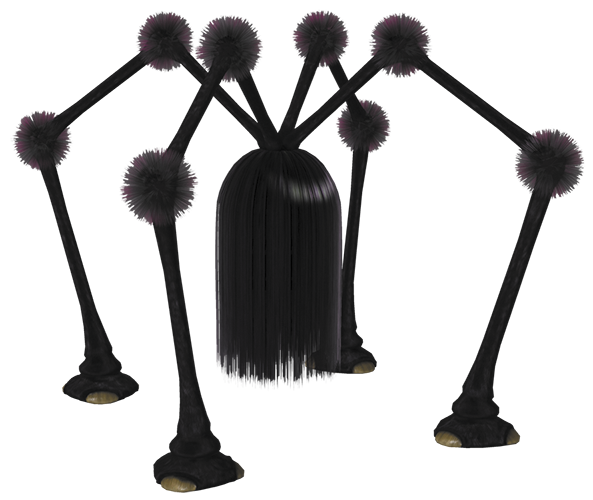
The Shaggy Longlegs
(Pseudoarachnia capillum)
I find this is the coolest looking of the "arachnorbs," personally. It functions exactly like the classic Beady Longlegs, but it has a poof of fuzz at every knobbly leg joint, and its central sphere is entirely hidden by its long, hanging, shiny black hair. It's a little silly, beautiful, and menacing all at once, also kind of bringing to mind a grudge ghost. It comes in a few color variations matching different environments, and also a "baldy long legs" variant, which just exposes the mostly featureless orb head.
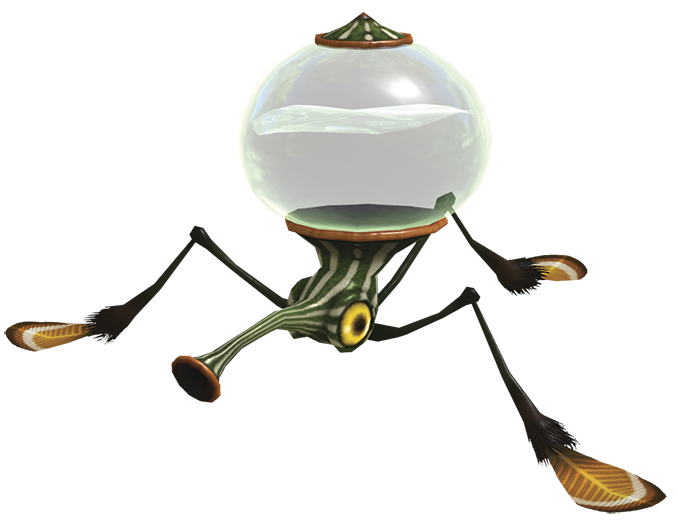
The Skeeterskate
(Gerridus clavomacula)
I really like the combination of animals on display here; it's first and foremost a tripodial alien water strider, skating across the water's surface on three long, thin legs, but the feet look kind of like orange feathers, or actually a lot like little fish fins. The central body consists of a large, spherical, transparent water tank and the head hangs beneath this, but rather than anything really insectoid, it's almost exactly the head of a pipefish! It uses the long, tubular mouth to suck water up into its sphere, and Olimar says it's actually collecting plankton! Most plankton feeders in our world continuously take in water through one orifice and pump it out through another, so the Skeeterskate's method isn't as efficient for feeding as it could be, but it ejects water back out through its mouth with enough force to function as a defense against horrible little predators, like Pikmin! It needs that, too, because only one Pikmin is all it takes to kill a Skeeterskate instantly. Brutal.
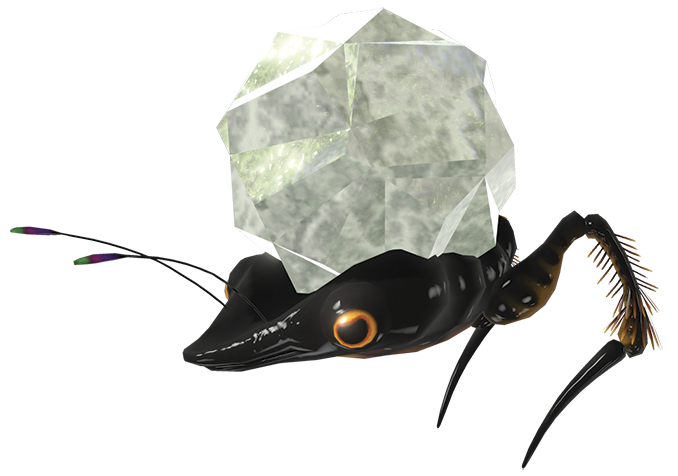
The Skutterchuck
(Hierodeciderit crystallosum)
Apparently a species of "Heavil," the Skutterchuck is an insectoid consisting of a black, spade-shaped head with two big goldfish-like eyes and two fuzzy cricket-like legs ending in long, black points. It also has antennae with rainbow colored tips, and it tends to carry a big round chunk of crystal on its concave upper surface. It's an herbivore said to graze on moss, but it can hurl the crystal to protect itself. It's also stated that it may scoop up a variety of objects, but the round crystals it prefers to wield are actually the molted shells of immature crushblats!
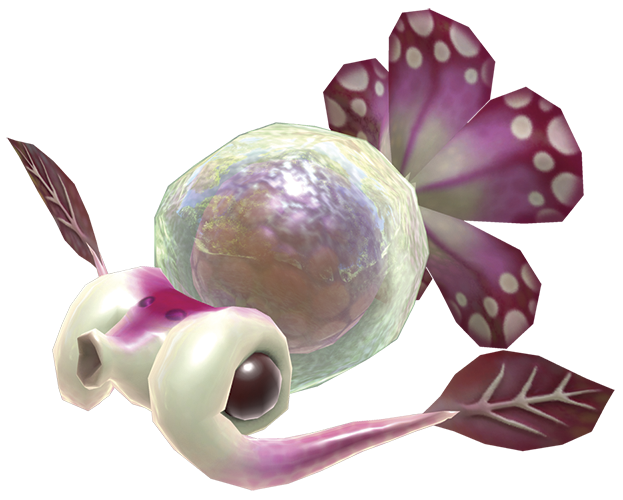
The Sputtlefish
(Pseudocephalopoda florascens)
A species of "squirdler," the Sputtlefish is a predator that can grab Pikmin with its two tentacles and can protect itself with a cloud of ink, which causes Pikmin to panic! It's also a really fun and unique design; it has a "tail resembling a fan of spotted pink and white flower petals, a spherical, translucent jelly body, and a head resembling that of a pop-eyed goldfish, except the flesh encircling the eyes continues into the two tentacles, each ending in a veiny leaf-shaped flipper. Its entire silhouette is like a fancy goldfish, really, with the fanned out tail and round midsection, but the details are more squidlike, and the result is neither a fish nor a mollusk but something that feels wonderfully alien. That's another thing I really love about the creatures in Pikmin; they hybridize familiar animal groups, but the results often look like an entirely new phylum, one that I could almost believe might evolve if there are, indeed, any planets out there in the universe with anything resembling multicellular animals.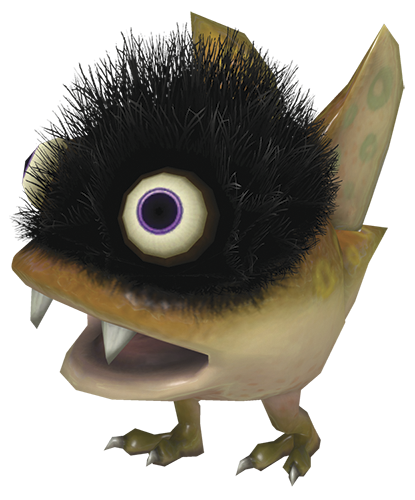

The Phosbat
(Tectupervus pteromys)
I LOVE THEM. They're cute, they're funny, and they're weird as heck! A
Phosbat is a little round head-body with a fanged, gaping mouth and two
little legs, a lot like a grub dog actually, but the two-toed feet are
clawed, it has a pair of vestigial flippery wings on its back, and
there's a dome of bristly black fuzz on top of its head, like a goofy
frizzy wig, with two large bulging eyeballs sticking out of it. What's
weird is that they emerge from fleshy, barnacle-like pods that are
clearly alive, and actually keep producing more Phosbats as needed to
maintain a stable population, so biologically speaking, the pod is a
Phosbat specialized entirely to replicate other Phosbats, kind of like
the "larvae" of some real-world invertebrates that just incubate
another, different larva in their body, except these don't die in the
process. The other weird thing about Phosbats is that light exposure,
even from agitating luminous fungi in their own caverns, can cause them
to disintegrate! Their little eyeballs even roll away!!! Oh no!!!!!

The Plasm Wraith
A callback to the last game's Water Wraith, this strange thing
initially appears as a golden brown amoeba with a swirly, oily surface
and a shiny, golden cube for a "nucleus." This is referred to in-game as
"the Mysterious Life Form," its body is invulnerable and its consumes
anything it can absorb into its goop. Bizarrely, the other creatures
encountered in the same environment seem like familiar species from the
rest of the game, but they splatter into the same gold "plasm" when
killed, implying that this being actually reconstructs copies of other
living things from its biomaterial.
The Mysterious Life Form only reveals its
"Plasm Wraith" form when lured outside of the tree it inhabits,
solidifying into an odd golden biped with a pot-bellied "torso," two
tapering bulbous legs and a big, round head, featureless other than a
circular hole in the front and two arm-like stubs, which it can stretch
into longer, sharper whiplike pseudopods! A very cool, very surreal
design that brings to mind a lot of different things; ancient clay
idols, the gooey "Yellow Devil" from Mega Man, and the inhuman eeriness of Evangelion Angels.
It's actually the final boss of the game, and is holding Captain Olimar captive. Why? We don't know. It fights desperately to prevent you from taking him back, but it doesn't evidently want to harm him, and its Japanese name alludes to it being some kind of god-like entity. It's obviously IMPORTANT. It means SOMETHING. But once you beat it up and kill it, the crew hardly wonders what was going on here at all. One admires its shapeshifting abilities. One is annoyed that it "doesn't know what it wants" and feels they were "doing it a favor" by putting it down. Louie says it "tastes dangerous" and smells citrusy, because of course he ate some of it. Olimar at least speculates that it might be key to understanding the evolution of the planet's lifeforms, but still doesn't seem terribly concerned with how unnatural it seems to be. And then there's the hilarious log entry by the botanist, Brittany:
"Wow, it really did not want to let go of Captain Olimar. Is that budding inter-species romance I smell? Anyway, I bet that gunk would make for some good lotion. I should've bottled some up so I could sell it back on Koppai."
From sarcastically shipping it with her captain to wondering if its goo is worth any money, this perfectly encapsulates one of the funnier aspects of this whole series; there's clearly a lot of weird, weird stuff going on with the Pikmin and their planet, the tiny cybernetic bugs running around, the remnants of a recognizable human civilization that looks abandoned only yesterday, the extradimensional entities attempting and failing to communicate something, but Olimar's people, a race of incredibly advanced intergalactic explorers, react to it all with an equally frustrating and adorable nonchalance. They might journey halfway across the cosmos to murder some sort of demigod, and their reactions are basically somewhere between "ew, yucky" and "wow, neat I guess!"

As much as I love the creature designs in this series...the most entertaining part of Pikmin really are these wretched little space elves.
It's actually the final boss of the game, and is holding Captain Olimar captive. Why? We don't know. It fights desperately to prevent you from taking him back, but it doesn't evidently want to harm him, and its Japanese name alludes to it being some kind of god-like entity. It's obviously IMPORTANT. It means SOMETHING. But once you beat it up and kill it, the crew hardly wonders what was going on here at all. One admires its shapeshifting abilities. One is annoyed that it "doesn't know what it wants" and feels they were "doing it a favor" by putting it down. Louie says it "tastes dangerous" and smells citrusy, because of course he ate some of it. Olimar at least speculates that it might be key to understanding the evolution of the planet's lifeforms, but still doesn't seem terribly concerned with how unnatural it seems to be. And then there's the hilarious log entry by the botanist, Brittany:
"Wow, it really did not want to let go of Captain Olimar. Is that budding inter-species romance I smell? Anyway, I bet that gunk would make for some good lotion. I should've bottled some up so I could sell it back on Koppai."
From sarcastically shipping it with her captain to wondering if its goo is worth any money, this perfectly encapsulates one of the funnier aspects of this whole series; there's clearly a lot of weird, weird stuff going on with the Pikmin and their planet, the tiny cybernetic bugs running around, the remnants of a recognizable human civilization that looks abandoned only yesterday, the extradimensional entities attempting and failing to communicate something, but Olimar's people, a race of incredibly advanced intergalactic explorers, react to it all with an equally frustrating and adorable nonchalance. They might journey halfway across the cosmos to murder some sort of demigod, and their reactions are basically somewhere between "ew, yucky" and "wow, neat I guess!"

As much as I love the creature designs in this series...the most entertaining part of Pikmin really are these wretched little space elves.
WAYS TO SUPPORT BOGLEECH.COM:


